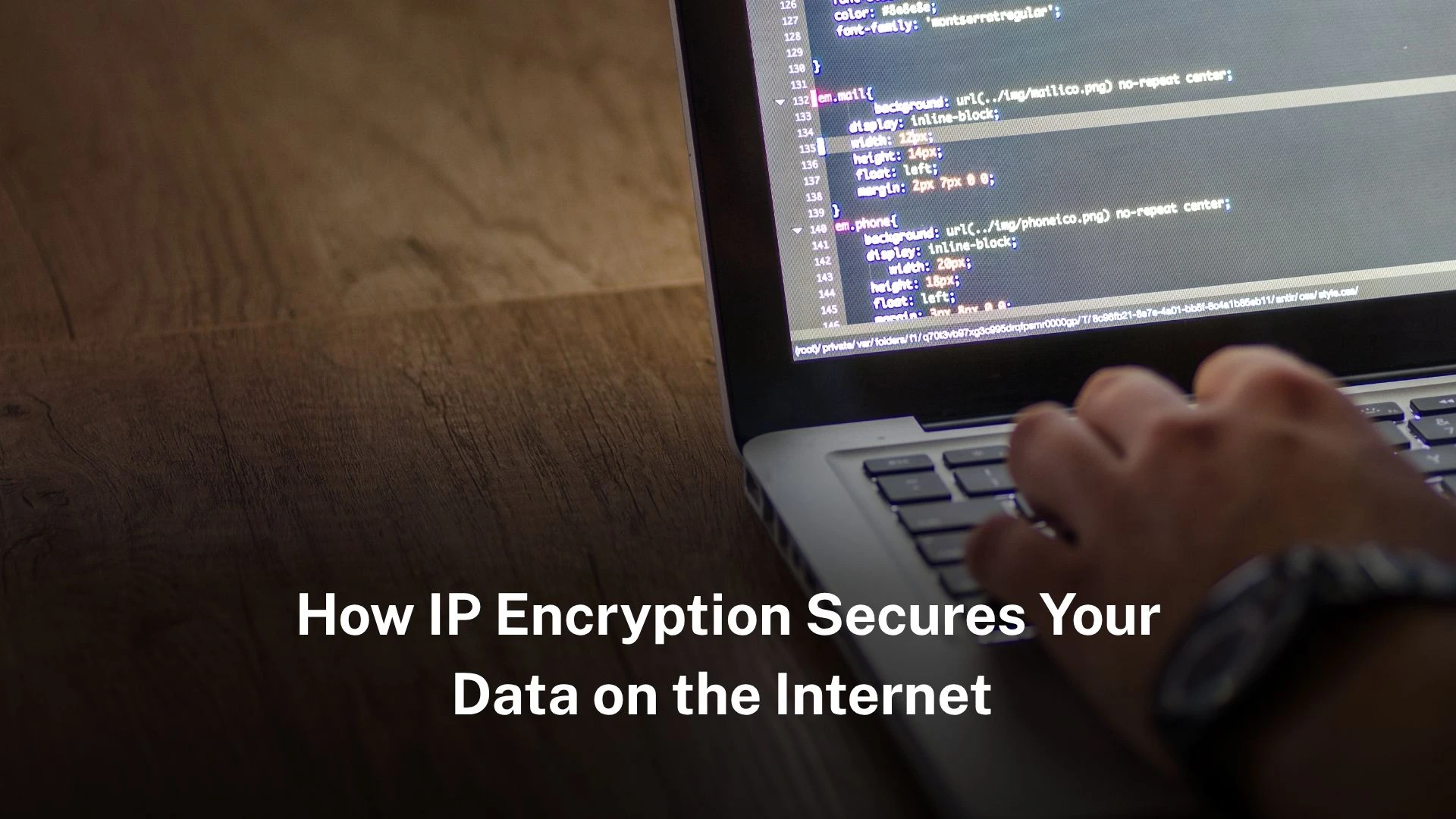Discover how IP encryption protects your online data, safeguarding privacy, integrity and authenticity as information travels across the internet.
Table of Contents
ToggleIP encryption shields your connections from eavesdroppers and tampering by encrypting and authenticating data packets.
Protocols like IPsec enable secure VPNs, defend against replay attacks, and ensure only trusted parties interact.
What is IP encryption?
Every time we send an email, transfer money, or make a video call, our data moves across the internet in the form of IP packets. Without protection, these packets are open to anyone with the right tools. They can be intercepted, read, or even modified by those with malicious intent. IP encryption changes this by locking these packets so they cannot be read or altered without permission. It is like sealing a letter inside an envelope, instead of sending it as an open postcard that anyone along the route could easily read. This simple yet powerful shift makes a world of difference in protecting our privacy. In everyday life, most of us would never post personal letters or sensitive documents on a public noticeboard, yet sending unencrypted data is surprisingly similar to doing just that. Encryption ensures that our digital footprints are not laid bare for strangers to see.
One of the most common forms of IP encryption is IPsec (Internet Protocol Security). Created in the mid-1990s by the Internet Engineering Task Force, IPsec was built to keep data safe from eavesdropping, tampering, and impersonation. Over the years, it has become a quiet but essential part of how we protect sensitive information on the internet, whether we realise it or not.
How IPsec works: encryption and authentication in action
IPsec does more than just scramble data. It verifies where the data came from and ensures it has not been changed along the way. It’s like sending a locked package with a verified return address and a tamper-evident seal, so the recipient can immediately see if it’s been opened or tampered with in transit.
Authentication Header (AH) checks the packet’s origin and confirms that it has not been altered. Encapsulating Security Payload (ESP) encrypts the contents of the packet, and sometimes the whole packet including its header. Internet Key Exchange (IKE) handles the behind-the-scenes work of agreeing on the keys and encryption methods. Security Associations (SAs) set the rules for each secure connection, including which keys to use and how long they are valid.
When IPsec is active, each packet is locked, labelled, and verified. On arrival, the packet is unlocked and checked before it is delivered to its final destination. This process happens almost instantly, even though it involves careful checking and decoding, which shows just how efficient modern encryption protocols have become.
IP encryption versus other security methods
IPsec works at the network layer, which means it protects everything that passes through your internet connection, not just specific websites or apps. This is different from HTTPS or TLS, which mainly protect web traffic. With HTTPS, you are securing the data you exchange with a particular website, like an online shop or a bank. IPsec, on the other hand, casts a much wider protective net.
Because IPsec covers all traffic, it is a popular choice for setting up virtual private networks (VPNs). With IPsec, your emails, video calls, file transfers, and internal tools can all be protected without needing to adjust individual apps. This makes it particularly useful for businesses that need to secure all types of data without relying on each application’s own security settings.
By offering this broader protection, IPsec acts as a sort of safety blanket for your internet traffic. Even if you are using older apps that might not have their own encryption, IPsec ensures the data travelling from these apps remains safe.
Modes of IPsec: transport and tunnel
IPsec can work in two ways: transport mode and tunnel mode.
Transport mode encrypts only the data part of the packet. The header, which shows where the packet is going, stays visible. This is useful when you are communicating directly between devices. For example, when two computers on the same company network need to talk to each other securely, transport mode provides a lightweight way to protect the data without adding too much complexity.
Tunnel mode encrypts the entire packet, including the header. The whole thing is wrapped in a new packet with a new header. This method is often used in VPNs to keep both the data and its destination private. Imagine placing a letter in a sealed envelope and then putting that envelope inside a larger, addressed package. To anyone intercepting the outer package, the contents and original destination remain completely hidden. Tunnel mode is ideal when security needs to cover every detail of the connection, especially over public or untrusted networks.
Why IP encryption matters
The benefits of IP encryption go beyond simply keeping secrets. It also ensures that data arrives unchanged and from a trusted source, which is essential for keeping systems safe and reliable. Without this level of protection, attackers could intercept or even alter data in transit, potentially causing major damage to businesses and individuals.
Confidentiality is provided by strong encryption algorithms like AES and ChaCha20-Poly1305, which make it extremely difficult for outsiders to decode the packets. These algorithms are considered industry standards and are widely trusted to keep even sensitive communications secure. Integrity is maintained through digital signatures and checks, so any tampered packet can be quickly rejected. This means the receiver can trust that the information they receive is exactly what was sent.
Authentication confirms that both ends of the connection are who they claim to be, helping prevent impersonation attacks. Anti-replay protection stops attackers from reusing old data to trick systems, a technique that can otherwise be used to bypass security measures.
In short, IP encryption does not just hide data. It actively protects the entire conversation, ensuring that the people and systems involved can trust each other. It forms a quiet, consistent layer of defence that operates in the background every time we browse, communicate, or transfer files online.
How IP encryption protects public and private networks
IP encryption is used in many everyday situations, often without us noticing. It is a vital tool that helps keep our digital world running securely.
Businesses use site-to-site VPNs to connect their offices securely over the internet, making sure that data sent between locations remains protected from external threats. Remote workers use VPNs to safely access company systems from home or while travelling, a practice that has become especially important as more people work flexibly. Even cloud services rely on IP encryption to build secure links between cloud data centres and local offices, ensuring that critical information can flow safely between platforms.
Transport mode can also be used to protect direct connections between two devices, like in some machine-to-machine communications and voice calls over the internet. For example, companies that run smart factories or manage connected vehicles often depend on this type of encryption to keep their internal communications private and secure. Voice over IP (VoIP) calls, which many of us make daily, can also benefit from IP encryption, preventing eavesdropping and maintaining call integrity.
Ultimately, whether it’s protecting a large organisation’s international network or safeguarding a private phone call, IP encryption provides a trusted shield that secures information at every step of its journey.
Expert voices on the power of encryption
Bruce Schneier, a respected cryptographer, has long supported the use of strong encryption. “Encryption works. Properly implemented strong crypto systems are one of the few things that you can rely on,” he wrote when public trust in internet privacy was shaken.
Stephen Kent, one of the key contributors to IPsec, summed it up plainly: “IPsec authenticates and encrypts packets of data to provide secure encrypted communication between two computers.”
Their comments remind us that, while no system is perfect, encryption remains one of the best defences we have.
Common threats and how IP encryption stops them
Without encryption, attackers can easily intercept and read your data. They might also try to tamper with it or send fake data pretending to be someone else. IP encryption makes this much harder.
Man-in-the-middle attacks are a common threat where an attacker secretly intercepts your data. IPsec defeats this by encrypting packets and verifying where they come from.
Replay attacks involve capturing your data and sending it again later to trick systems. IPsec uses sequence numbers to detect and block this behaviour.
Spoofing happens when an attacker pretends to be a trusted device. With IPsec, the identity of each device is verified before data is accepted.
Real-world uses of IP encryption
IP encryption is part of many daily processes we might not think about. Banks use it to protect financial transactions. Companies rely on it to connect branch offices securely. Governments use it to shield sensitive communications. Cloud services like Amazon Web Services offer IPsec-based VPNs to link local networks to cloud systems.
The move to remote work has made IP encryption even more critical. When employees work from home, VPNs built on IPsec help keep company data secure over public internet connections.
Challenges in using IP encryption
Although powerful, IP encryption is not always easy to set up. The protocols can be complex, and small mistakes can cause connections to fail. There is also some performance cost, as encrypting and decrypting data uses processing power.
Making different systems work together can also be tricky, especially if they come from different vendors. Careful planning, regular testing, and clear policies are needed to keep everything running smoothly.
Best practices for secure IP encryption
Use modern encryption methods like AES-GCM or ChaCha20-Poly1305 and avoid older, weaker algorithms.
Choose IKEv2 for faster, more secure key exchanges.
Set security policies to rotate encryption keys regularly.
Use digital certificates instead of simple passwords to verify devices.
Test connections carefully to ensure different systems can communicate securely.
Keep software up to date and monitor network activity to catch potential problems early.
The future of IP encryption
IP encryption is expected to evolve alongside new technologies. Faster and more efficient encryption methods will support growing demands from mobile networks and the Internet of Things. As quantum computing develops, there will also be a push towards encryption methods that can resist quantum-based attacks.
While newer protocols like QUIC and TLS 1.3 offer strong security at the application level, IPsec will likely remain essential for protecting network-wide traffic and building secure VPNs.
FAQs
What is the difference between IPsec and HTTPS?
HTTPS protects web pages and works at the application level, while IPsec protects all traffic at the network level.Can IPsec be used on public Wi-Fi?
Yes, IPsec works well on public networks and keeps your data private even on unsecured Wi-Fi connections.Does IP encryption slow down internet speed?
There can be a small performance impact, but modern systems and hardware acceleration reduce this to minimal levels.Is IPsec enough to stop government surveillance?
IPsec makes surveillance much harder, but no system is completely immune. Strong encryption and careful configuration provide excellent protection.How does IPsec prevent replay attacks?
IPsec uses unique sequence numbers for each packet. This ensures that old or duplicated packets are recognised and rejected.




